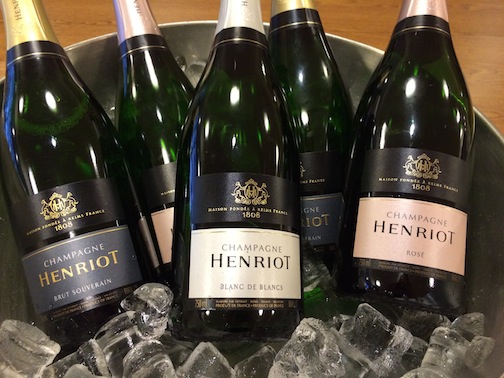There are many sparkling wines that are made in the same way as Champagne: Sparkling wines from California, Penedès in Spain, Lombardy in Italy; even in a remote place such as Tasmania. These areas make very good, and sometimes, great sparkling wines, but they are not Champagne. Champagne comes from a specific area in the North-East of France which is in fact called Champagne.
In New York City, Champagne sales have consistently increased over the past couple of years. It is not only a long-established, well-known region, but one which is constantly reinventing itself. Since there are many wine options available to the wine consumer in New York, it is difficult to always be the most popular. But Champagne has always kept the spot of the number one luxury sparkling wine of choice. No other region has ever taken its place.
Henriot
 On February 17th, I was able to taste a few of the Henriot Champagnes with current CEO, Thomas Henriot. He talked about how his family has tried to keep many of the traditional elements that have always made their Champagne high quality, but they realized that they needed to redesign new labels to keep up with current trends. Thomas said, “Any tradition is an innovation which has succeeded.”
On February 17th, I was able to taste a few of the Henriot Champagnes with current CEO, Thomas Henriot. He talked about how his family has tried to keep many of the traditional elements that have always made their Champagne high quality, but they realized that they needed to redesign new labels to keep up with current trends. Thomas said, “Any tradition is an innovation which has succeeded.”
He explains that there is nothing wrong with changing some aspects of his family tradition, as long as it is an improvement, and then that improvement will become the new tradition. This idea reminded me of what is unique about New York City. Many people come here, proud of their culture and heritage, but they are not afraid to try new things.
Also, he talked about making what was old new again. For the first time this year, they will release a limited 1000 bottle production of a special label called Cuve 38. This is named after a tank, tank 38, which is used for the Chardonnay grape that comes from a specific Grand Cru vineyard (top vineyard). This new blend will come from “reserve” wines that have been saved from 1990 to 2007. It will represent several generations of the Henriot family, as well as several vintages and both tradition and innovation.
Veuve Clicquot
 On February 13th, the day before Valentine’s Day, I was also able to taste Champagne with a representative from one of the most well known Champagne houses, Veuve Clicquot. What is more magical than Champagne? Rosé Champagne!
On February 13th, the day before Valentine’s Day, I was also able to taste Champagne with a representative from one of the most well known Champagne houses, Veuve Clicquot. What is more magical than Champagne? Rosé Champagne!
Veuve Clicquot is a perfect example of a Champagne house that has kept current with trends. They have great packaging ideas, they speak to both younger and older wine drinkers, but they always give respect to their history. The image aside shows the top of the cork with a picture of Madame Clicquot. She took over her husband’s wine business when she was widowed at 27. She helped to develop new techniques that are part of Veuve Clicquot’s success as a Champagne house today.
Tradition + Innovation = Magic
Champagne keeps what is great about their tradition, but they are not afraid to improve on certain things that must change to speak to modern wine drinkers.
Many people in New York City typically have an empty refrigerator with the exception of a bottle of Champagne, because they never know when they will need a little bit of magic.
Cathrine's Recommendations
Everyday Drinking Wine (less than $15)
Aria Estate Cava Brut ($11) is a sparkling wine made in the “traditional method”, which is the same method as Champagne. It is from Penedès, Spain and has ripe apple notes with a hint of smoke and a clean finish.
Special Occasion Wine (from $15 to 50)
Henriot Souverain Brut Champagne ($37) pure apricot fruit with toasty notes and crisp finish. A pretty Champagne for those who enjoy more delicate flavors.
Fantasy Wine (over $50)
Veuve Clicquot Rosé Champagne ($60) richer body, much more complex with aromas of nuts, chalky minerality and fresh strawberries. This Champagne has fine bubbles that caress the palate.












